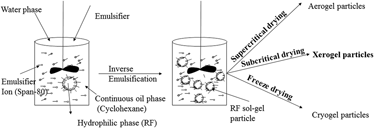Crossref Citations
This article has been cited by the following publications. This list is generated based on data provided by
Crossref.
Arenillas, Ana
Menéndez, J. Angel
Reichenauer, Gudrun
Celzard, Alain
Fierro, Vanessa
Maldonado Hodar, Francisco José
Bailόn-Garcia, Esther
and
Job, Nathalie
2019.
Organic and Carbon Gels.
p.
149.
Kharissova, Oxana V.
Kharisov, Boris I.
and
Oliva González, Cesar M.
2019.
Carbon–Carbon Allotropic Hybrids and Composites: Synthesis, Properties, And Applications.
Industrial & Engineering Chemistry Research,
Vol. 58,
Issue. 10,
p.
3921.
Gaikwad, Mayur M.
Kakunuri, Manohar
and
Sharma, Chandra S.
2019.
Enhanced catalytic graphitization of resorcinol formaldehyde derived carbon xerogel to improve its anodic performance for lithium ion battery.
Materials Today Communications,
Vol. 20,
Issue. ,
p.
100569.
Erkhova, Ludmila V.
Presniakov, Igor A.
Afanasov, Michail I.
Lemenovskiy, Dmitry A.
Yu, Haojie
Wang, Li
Danilson, Mati
and
Koel, Mihkel
2020.
Ferrocene Introduced into 5-Methylresorcinol-Based Organic Aerogels.
Polymers,
Vol. 12,
Issue. 7,
p.
1582.
Lee, Jong-Hoon
and
Park, Soo-Jin
2020.
Recent advances in preparations and applications of carbon aerogels: A review.
Carbon,
Vol. 163,
Issue. ,
p.
1.
Yoo, Jihoon
Yang, Inchan
Kwon, Dahye
Jung, Meenkyoung
Kim, Myung-Soo
and
Jung, Ji Chul
2021.
Low‐Cost Carbon Xerogels Derived from Phenol–Formaldehyde Resin for Organic Electric Double‐Layer Capacitors.
Energy Technology,
Vol. 9,
Issue. 4,
Ibarra Torres, Cynthia E.
Serrano Quezada, Thelma E.
Kharissova, Oxana V.
Kharisov, Boris I.
and
Gómez de la Fuente, Ma. Idalia
2021.
Carbon-based aerogels and xerogels: Synthesis, properties, oil sorption capacities, and DFT simulations.
Journal of Environmental Chemical Engineering,
Vol. 9,
Issue. 1,
p.
104886.
Mayoral, E. Pérez
Matos, I.
Bernardo, M.
Durán-Valle, C.
and
Fonseca, I.
2021.
Emerging Carbon Materials for Catalysis.
p.
299.
Peikolainen, Anna-Liisa
Uibu, Mai
Kozlova, Jekaterina
Mändar, Hugo
Tamm, Aile
and
Aabloo, Alvo
2021.
Carbon xerogel from 5-methylresorcinol-formaldehyde gel: The controllability of structural properties.
Carbon Trends,
Vol. 3,
Issue. ,
p.
100037.
Gaikwad, Mayur M.
Sarode, Krishna K.
Pathak, Anil D.
and
Sharma, Chandra S.
2021.
Ultrahigh rate and high-performance lithium-sulfur batteries with resorcinol-formaldehyde xerogel derived highly porous carbon matrix as sulfur cathode host.
Chemical Engineering Journal,
Vol. 425,
Issue. ,
p.
131521.
Santos-Gómez, Lucía dos
Cuesta, Nuria
Cameán, Ignacio
García-Granda, S.
García, Ana B.
and
Arenillas, Ana
2022.
A promising silicon/carbon xerogel composite for high-rate and high-capacity lithium-ion batteries.
Electrochimica Acta,
Vol. 426,
Issue. ,
p.
140790.
Lu, Qing
Kong, Lingqian
Liang, Bo
and
Zhao, Jinsheng
2022.
Hard Carbon Derived from A New Type Resorcinol/2-Thenaldehyde Resin as High-Performance Anode Materials for Lithium-Ion Batteries.
International Journal of Electrochemical Science,
Vol. 17,
Issue. 12,
p.
221274.
Kraiwattanawong, Kriangsak
2023.
Porosity development of templated porous carbons dried by vacuum as carbon electrodes for electric double-layer capacitors.
Chemical Engineering Science,
Vol. 268,
Issue. ,
p.
118401.
Dashairya, Love
Chaturvedi, Vikash
Kumar, Abhishek
Mohanta, Tandra Rani
Shelke, Manjusha
and
Saha, Partha
2023.
A benign strategy toward mesoporous carbon coated Sb nanoparticles: A high-performance Li-ion/Na-ion batteries anode.
Solid State Ionics,
Vol. 396,
Issue. ,
p.
116243.
Lawtae, Panuwat
Nagaishi, Shintaroh
Tangsathitkulchai, Chaiyot
Iwamura, Shinichiroh
and
Mukai, Shin R.
2023.
Improving porous properties of activated carbon from carbon gel by the OTA method.
RSC Advances,
Vol. 13,
Issue. 21,
p.
14065.
Veselov, Grigory
and
Vedyagin, Aleksey
2023.
Resorcinol–Formaldehyde-Derived Carbon Xerogels: Preparation, Functionalization, and Application Aspects.
Materials,
Vol. 16,
Issue. 19,
p.
6566.
Bilican, Abdurrahman
Sharma, Priyanka
Tran, Nguyen Khang
Weidenthaler, Claudia
and
Schmidt, Wolfgang
2023.
Superfast Synthesis of Carbon Xerogels.
ACS Omega,
Vol. 8,
Issue. 48,
p.
45599.
Selvaraj, Seethalakshmi
Ganesan, Arya
P V, Sreya
Singaram, Vengatesan
Pattanayak, Deepak K.
and
Chandrasekaran, Naveen
2023.
In situ copper-ion catalyzed synthesis of copper containing poly(isocyanurate-urea) xerogels with antibacterial activity and biocompatibility for biomedical applications.
New Journal of Chemistry,
Vol. 47,
Issue. 45,
p.
20943.
Flores-López, Samantha L.
Lobato, Belén
Rey-Raap, Natalia
Cameán, Ignacio
García, Ana B.
and
Arenillas, Ana
2023.
Role of Crystalline Si and SiC Species in the Performance of Reduced Hybrid C/Si Gels as Anodes for Lithium-Ion Batteries.
Nanomaterials,
Vol. 13,
Issue. 3,
p.
458.
Choi, Jongyun
Jung, Ji Chul
and
Jung, Wonjong
2024.
Advances in Carbon Xerogels: Structural Optimization for Enhanced EDLC Performance.
Gels,
Vol. 10,
Issue. 6,
p.
400.






